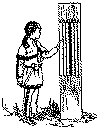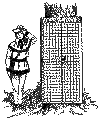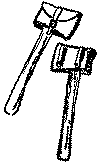By Dan Beard

Fig. 239.
Fancy Throwing
For ordinary field work, make a target on a broad, two inch pine plank, and do it by marking the plank with chalk, or, better still, paint the board white and the stripes black, as in Fig. 240.

Fig. 240.
A Tomahawk Target
The breadth of the bull's-eye, that is, the center stripe, must depend upon the skill of the tomahawkers and the distance of the throw. Fig. 240 is a target for plain tomahawk throwing. The bull's-eye counts four and the white spaces on each side three, two, and one, respectively.
Expert Tomahawking
For real expert and figure work another target is necessary. This is made of two two-inch planks, and is divided up into squares, as shown in Fig. 241. Experts are supposed, not only always to hit the vertical line, but also to hit any one of the horizontal lines they may select, and this from a distance of ten or more yards.

Fig. 241.
A Bull's-Eye Hit
The bull's-eye in Fig. 241 counts seventeen, ten for horizontal and seven for vertical. A throw above or below the " 0 " on this target takes off from one to four points from the thrower's score, as is indicated by the minus signs on the target.
For exhibition team-work the target should be approached upon a run, the leader or captain being a little in advance of the second boy, and the second boy in advance of the third, and so on. As the captain delivers his throw he gives a whoop, and this is imitated by each of the team in quick succession, so that they come up with a succession of whoops that are exciting and inspiring alike to players and spectators. As the last hatchet sinks its keen edge into the target, the players should be lined up like a How to Throw a Tomahawk file of soldiers and each bring up his right hand to his cap, palm out, as in Fig. 20, and make a graceful salute by bringing the hand back to his side with a quick sweep of the arm.
The little cut (Fig. 242) shows the modern tomahawk or camp axe in its sheath, so arranged that it may be belted like a sword to the side of the camper or tomahawking Son of Daniel Boone.

Fig. 242.
Modern Camp Axes and Sheaths
It isn't necessary for me to tell a true Boy Pioneer that he must learn to handle his axe so as not to endanger himself or others. Care and skill in everything are the marks that characterize a manly boy. But if you have a club to practice tomahawk throwing you should have some good form of initiation.